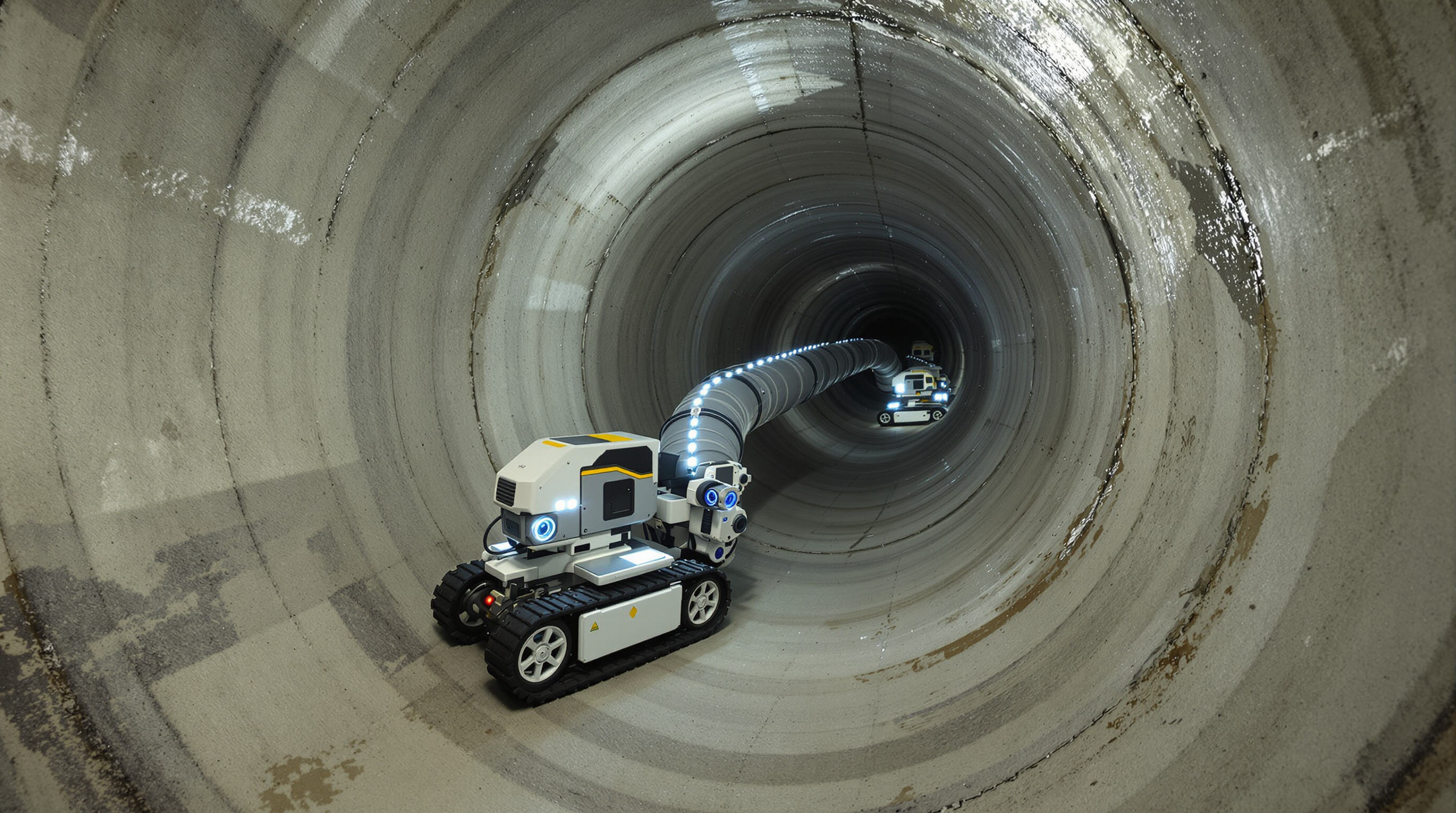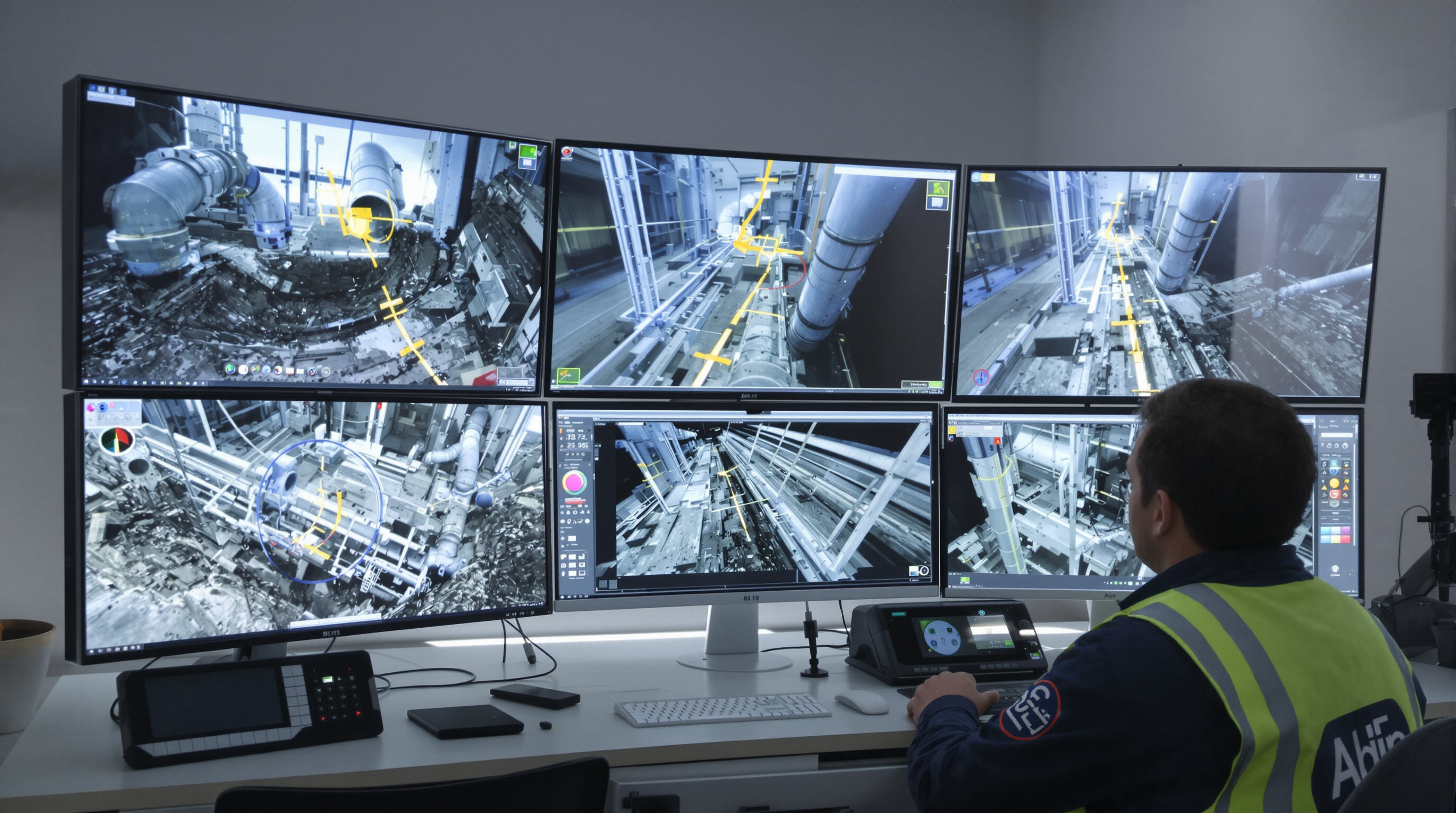How Pipe Inspection Cameras Work to Identify Cracks and Blockages
Understanding the Basic Operation of Pipe Inspection Cameras in Pipeline Diagnostics
Today's pipe inspection gear typically relies on robotic crawlers or those flexible push rods that snake through pipes while carrying high res cameras and lenses that automatically level themselves. The lighting on these systems is pretty impressive too, with LED arrays shining bright enough (some top models hit around 10,000 lumens) to spot tiny cracks just half a millimeter wide. Technicians watch everything unfold on their handheld controllers, constantly tweaking the camera angles so they can get a good look at pipe joints, areas where corrosion has set in, or places where sediment has built up, all without having to dig anything up. According to a recent report from the Pipeline Infrastructure Institute in 2024, these crawling inspection systems cut down on mistakes during diagnosis by about 41 percent when compared to old fashioned manual checks.
Real-Time CCTV Video for Immediate Detection of Cracks, Blockages, and Root Intrusions
CCTV pipeline inspections detect multiple issues simultaneously through high-definition video, capturing:
- Structural defects: Hairline fractures, joint separations, and wall thinning from corrosion
- Blockages: Grease accumulation, mineral deposits, and foreign objects
- Biological intrusions: Root penetrations and microbial-induced corrosion
Operators geo-tag problem areas using built-in locators accurate to ±10 cm, enabling precise repairs. In stormwater systems, this technology identifies inflow sources contributing to 73% of sewage overflow incidents.
The Growing Demand for Non-Invasive Pipe Inspection in Urban Infrastructure Maintenance
Chicago, Tokyo and several other major cities have started requiring inspections every three years for pipes that are older than two decades. This comes as infrastructure gets older and environmental rules get tougher. The good news is that these non invasive inspection techniques actually help local governments save between twelve thousand and eighteen thousand dollars per mile on digging costs. Plus they cut down on service interruptions by around eighty percent which makes everyone happier. Looking ahead, experts predict the market for tools used to check pipes will expand at about seven point two percent each year until 2030. More water companies and building maintenance teams are starting to adopt these technologies as well.
Key Technologies Powering Pipe Inspection Cameras
Modern pipe inspection cameras combine advanced engineering with digital innovation to address complex pipeline challenges. These systems achieve 98% diagnostic accuracy in industry field tests (NASSCO 2024), transforming how professionals assess underground infrastructure.
HD Imaging, Self-Leveling Lenses, and Recording Capabilities in Modern Pipe Inspection Cameras
Today’s 1080p HD cameras detect cracks as narrow as 1 mm via real-time video. Self-leveling mechanisms maintain optimal viewing angles in pipes with 45° inclines, while integrated defogging algorithms counteract humidity distortion. Leading systems record inspections in H.265 format, creating timestamped evidence for compliance reports and repair planning.
High-Resolution Cameras in Robotic Crawlers for Clear Visibility in Complex Pipelines

Robotic crawlers with 4K imaging navigate 90° bends and 300 mm diameter pipes using torque-balanced hybrid cables. Multi-spectral LED arrays adapt lighting patterns based on material—side illumination for concrete joints, focused beams for metal welds. These units withstand 10-bar water pressure during 8-hour operations in municipal sewer networks.
CCTV Inspection Technology: Enabling Precise Assessment of Sewer and Drain Conditions
Closed-Circuit Television (CCTV) systems provide NASSCO-compliant condition grading through synchronized locator data and geotagged video. Dual-axis pan/tilt cameras perform 360° scans at junctions, identifying root intrusions with 2 mm positional accuracy. Municipalities report 40% faster survey times compared to traditional methods (Water Infrastructure Journal 2023).
Limitations of Standard Cameras in Low-Light or Severely Corroded Pipe Environments
Legacy systems struggle in environments below 10 lux or where pipe wall corrosion exceeds 80%. New solutions include LiDAR-equipped crawlers that map degraded pipes and thermal sensors that detect temperature variations in blocked drains, improving visibility where standard optics fail.
AI and Machine Learning in Automated Defect Detection

AI-Powered Image Analysis for Accurate Identification of Cracks and Blockages
Today's pipeline inspection systems are getting smart thanks to AI technology that spots defects at around 97% accuracy, which is actually about 40 percentage points better than what humans can manage according to Water Infrastructure Journal from last year. These systems rely on convolutional neural networks that have been trained using vast collections of pipe images, allowing them to catch tiny cracks as small as a millimeter, notice when pipes are partially blocked, and even spot signs of corrosion before it becomes serious. What makes this different from traditional methods is that AI doesn't get tired or distracted. It works just as well whether looking at narrow pipes full of sediment or larger ones with cleaner surfaces, so those hard to see problems don't slip through during important inspections.
Integrating Machine Learning Into Sewer Inspection Workflows for Faster Condition Assessment
Cities across the country are now using machine learning to analyze CCTV footage on the fly, cutting down on inspection time by almost two thirds according to recent data from major urban areas like Chicago and Los Angeles. These smart systems spot problems such as roots getting into pipes or sediment building up inside them, but they also know when something isn't really an issue at all. They ignore things like passing shadows or water reflections that might otherwise cause unnecessary alarm. Because of this smart filtering, maintenance teams can get out there and fix serious problems much faster than before. The 2024 Urban Infrastructure Efficiency Report actually shows how quickly response times have improved since these systems were put in place last year.
Case Study: Reducing False Positives in Municipal Systems With AI-Enhanced Pipe Inspection Cameras
A municipal water authority reduced false positive alerts by 52% after deploying AI-enhanced cameras across its 2,100-mile sewer network. The system’s adaptive learning distinguished actual cracks from surface scratches, cutting unnecessary excavation requests. Over 18 months, this prevented $740,000 in wasted labor (Municipal Water Systems Review 2023).
Emerging Trend: Transition From Manual Review to Automated, Intelligent Diagnostics
The industry is shifting toward fully automated reporting systems that deliver analyzed results within minutes of survey completion. These platforms combine 3D pipe modeling with historical failure data to predict blockage formation and crack propagation—reducing emergency repair incidents by 38% in early-adopter cities.
Applications of Pipe Inspection Cameras in Sewer and Drain Systems
Pipe inspection cameras have become indispensable tools across multiple sectors, offering precise diagnostics while preserving pipeline integrity. They enable targeted interventions without destructive excavation, supporting sustainable urban maintenance.
Using Crawler Cameras for Inspecting Hard-to-Reach Sections and Detecting Corrosion
Robotic crawler cameras excel in complex networks, especially large-diameter sewers and industrial drains. With articulating heads and 360° lighting, they capture HD footage of internal surfaces. Operators detect early-stage corrosion by analyzing texture changes and pitting, often spotting wall thickness loss as small as 0.5 mm.
Detecting Cracks and Blockages in Residential, Commercial, and Municipal Plumbing Systems
Modern cameras resolve issues across all scales—from household drains to city-wide sewers. In homes, they locate hairline cracks causing slow drainage; in municipal systems, they identify sediment threatening stormwater capacity. A single inspection differentiates between mineral deposits, grease clogs, and structural failures, guiding efficient remediation.
Identifying Root Intrusions, Grease Buildups, and Structural Damage in Stormwater Systems
Advanced CCTV systems detect root filaments at 0.3 mm resolution, allowing early intervention before pipe collapse. Thermal imaging identifies temperature anomalies from grease buildup in commercial kitchen drains, while laser profiling maps pipe ovality to assess structural health in aging stormwater conduits.
Challenges in Standardization: Varying Regulatory Requirements Across Inspection Markets
Despite technological progress, inconsistent international standards complicate cross-border inspections. European codes may require reporting of 2 mm cracks, while North American jurisdictions often prioritize blockages over minor corrosion. This variability forces teams to customize reporting formats and calibrate equipment for each region.
FAQ
What are pipe inspection cameras used for?
Pipe inspection cameras are used to diagnose cracks, blockages, and corrosion in pipelines without invasive digging. They help in identifying structural defects, biological intrusions, and blockages in sewer, drain, and plumbing systems.
How accurate are modern pipe inspection systems?
Modern pipe inspection systems achieve up to 98% diagnostic accuracy, thanks to high-resolution cameras, AI, and machine learning technologies that aid in precise detection and analysis of pipeline conditions.
What benefits do AI and machine learning provide in pipe inspections?
AI and machine learning enhance pipe inspections by accurately identifying defects with a higher precision than human assessments, reducing inspection times, and filtering out false positives for efficient maintenance operations.
Table of Contents
- How Pipe Inspection Cameras Work to Identify Cracks and Blockages
- Key Technologies Powering Pipe Inspection Cameras
- HD Imaging, Self-Leveling Lenses, and Recording Capabilities in Modern Pipe Inspection Cameras
- High-Resolution Cameras in Robotic Crawlers for Clear Visibility in Complex Pipelines
- CCTV Inspection Technology: Enabling Precise Assessment of Sewer and Drain Conditions
- Limitations of Standard Cameras in Low-Light or Severely Corroded Pipe Environments
-
AI and Machine Learning in Automated Defect Detection
- AI-Powered Image Analysis for Accurate Identification of Cracks and Blockages
- Integrating Machine Learning Into Sewer Inspection Workflows for Faster Condition Assessment
- Case Study: Reducing False Positives in Municipal Systems With AI-Enhanced Pipe Inspection Cameras
- Emerging Trend: Transition From Manual Review to Automated, Intelligent Diagnostics
-
Applications of Pipe Inspection Cameras in Sewer and Drain Systems
- Using Crawler Cameras for Inspecting Hard-to-Reach Sections and Detecting Corrosion
- Detecting Cracks and Blockages in Residential, Commercial, and Municipal Plumbing Systems
- Identifying Root Intrusions, Grease Buildups, and Structural Damage in Stormwater Systems
- Challenges in Standardization: Varying Regulatory Requirements Across Inspection Markets
- FAQ


